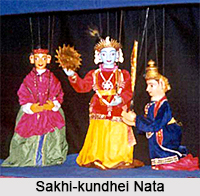 Sakhi-kundhei Nata is the traditional string puppetry still extant in Orissa. So far only a few troupes of this fascinating form have been located in remote rural areas. It is not clear why the epithet sakhi is used to designate their puppets. Some surmise that the name arose because the form earlier used to present shows based exclusively on Krishna legends. This feature Radha`s sakhis or female companions as well. According to another opinion, sakhi is often used as a term of endearment. Since the puppets are cute dolls and acquire a kind of life when manipulated, they were endearingly called sakhi-kundhei.
Sakhi-kundhei Nata is the traditional string puppetry still extant in Orissa. So far only a few troupes of this fascinating form have been located in remote rural areas. It is not clear why the epithet sakhi is used to designate their puppets. Some surmise that the name arose because the form earlier used to present shows based exclusively on Krishna legends. This feature Radha`s sakhis or female companions as well. According to another opinion, sakhi is often used as a term of endearment. Since the puppets are cute dolls and acquire a kind of life when manipulated, they were endearingly called sakhi-kundhei.
The puppets are made of light wood and, like the Kathputli of Rajasthan, have no legs but long flowing skirts. However, they have more joints as the hands and torso are also made of wood. Figures representing major characters have joints at their neck, shoulders, and elbows as well. Five to seven strings attached to the puppet are usually tied to a triangular wooden prop. Orissa temple sculptures and pothi chitras that are drawings in palm-leaf manuscripts have inspired the conception of most puppets. The costumes, music, and style of presentation are somewhat similar to those of the Yatra, operatic in character, where singing dominates over prose dialogue. The puppeteers` prose dialogues are often impromptu. The music admirably blends folk with sophisticated Odissi, the singing style close to that of the traditional Chhanda form.
This article is a stub. You can enrich by adding more information to it. Send your Write Up to content@indianetzone.com




















